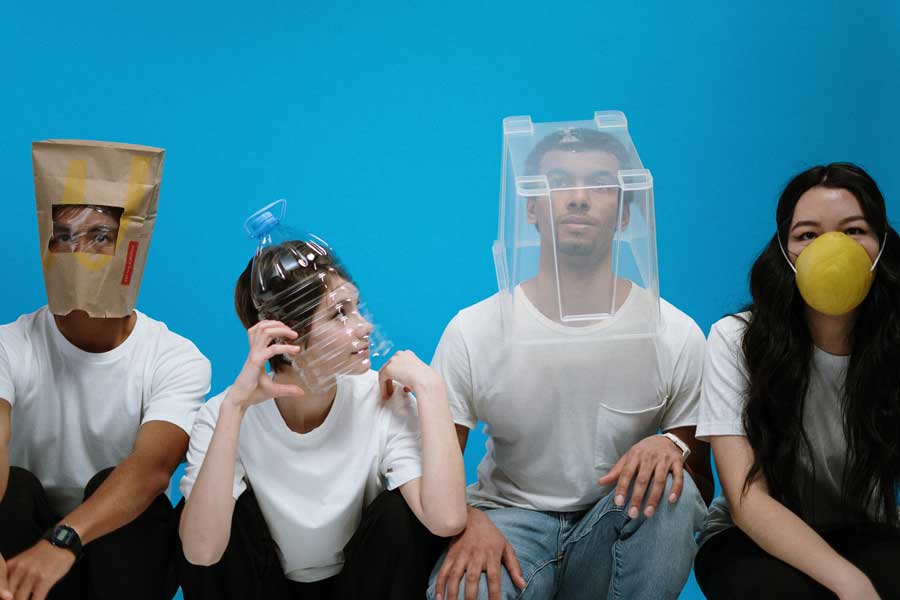
Safe Spaces, Happy Faces: How Employers Benefit When They Prioritise Workplace Security
Should masks be compulsory in a wider range of workplaces? Should fever detection be mandatory in environments that seem to encourage Covid-19 transmission? We discuss whether responsible employers should be going beyond minimum standards to protect their workforces and the wider community.
There is still much for scientists to learn about novel coronavirus Covid-19. What they know for certain is that it’s very contagious and is transmitted most commonly through airborne particles: coughing, sneezing, breathing and speaking; and through contact: shaking hands, touching a handrail, countertop, or other surfaces.
Authorities around the world have pressed us to wash our hands with soap more thoroughly and more regularly, and to use hand sanitiser where that isn’t practical such as in shops or, soon in the UK, in bars and restaurants. Similarly, businesses are being urged to ensure all surfaces are sanitised much more regularly.
So, that helps take care of the surface transmission. Perhaps not perfectly, but it’s a huge help.
As for airborne transmission, the guidance seems somewhat more erratic. Some say masks are good, others say not so much. The truth is it rather depends on the circumstances.
Hospitals first introduced surgical masks in the late 1700s. In a clinical setting, they are primarily used to prevent visible sprays or splashes of fluid. It wasn’t until the outbreak of Spanish flu in 1919 that these masks made any meaningful transition to public use.
On April 8, the World Health Organisation said there was no evidence to suggest that wearing a face mask would prevent someone from picking up the virus, but that they do stop people from spreading it.
Professor David Heymann, who chaired the WHO’s scientific and technical advisory group said that masks are “only for the protection of others, not for the protection of oneself” – unless, as mentioned previously, they are clinical grade masks being used within healthcare settings.
Studies from the University of Edinburgh back this up, showing that a covering over the mouth and nose can reduce the distance travelled by exhaled breath by more than 90%. There is a caveat here too, though, in that unless the mask is fitted properly, they can create strong jets of air to the side instead. The team said that only masks with a tight seal to the face could prevent the escape of virus-laden particles.
Earlier this week, Professor Peter Piot, director of the London School of Hygiene and Tropical Medicine, and the man who co-discovered the Ebola virus in 1976, said in an interview with the Guardian that he couldn’t believe the UK government wasn’t making face masks mandatory.
“I don’t understand why it is not official policy to have compulsory face masks not only on public transport but when you go into public places, enclosed places and shops and all that,” he said. He went on to explain, though, that a lack of hard scientific evidence from scientists and the highly-charged political nature of having to enforce such rules meant such a declaration would be hard to make.
“I can imagine the debates. Britain is a nation of people who want absolute evidence, and the evidence for masks is more ecological, as we say. There are very few randomised controlled trials. But even if they are not 100% effective, if everybody wears one, we know from other countries that it works.”
The case for face masks is clear: if everyone wears one, we reduce the spread. A face mask will also prevent transmission from asymptomatic or pre-symptomatic carriers.
Symptoms are another issue on which scientists are somewhat divided. In April, the CDC in the United States said: “We now know from recent studies that a significant portion of individuals with coronavirus lack symptoms”. The WHO followed up in June, however, saying it believed asymptomatic transmission to be “very rare”.
In a statement the next day, the WHO clarified its position saying that its statement was based on a small number of contact-tracing studies in China. Experts believe that while most transmission comes from people who are exhibiting Covid-19 symptoms, 16% of asymptomatic infected people can transmit it. Some unpublished disease models suggest that as many as 40% of people infected by Covid-19 could be asymptomatic while a lab in Iceland suggested it could be as high as 50%.
That said, Dr Maria Van Kerkhove, the WHO’s head of emerging diseases and zoonoses unit, said she believed that the figures could be skewed from misclassification. Rather than being completely asymptomatic, they were infected and simply hadn’t exhibited the symptoms yet. A CDC study in Washington State, for example, tested patients in a nursing facility. 13 of the patients who tested positive reported no symptoms. 10 of them later started exhibiting them.
“Most of the people who were thought to be asymptomatic aren’t truly asymptomatic,” said Dr Van Kerkhove. “When [WHO] went back and interviewed them, most of them said, ‘Actually, I didn’t feel well, but I didn’t think it was an important thing to mention. I had a low-grade temperature, or aches, but I didn’t think that counted.'”
It’s easily done, and we all do it. We wake up for work in the morning feeling a little rough. Perhaps we didn’t sleep well, perhaps dinner didn’t sit right. We brush it off and get on with our day, vaguely aware that something might not be quite right, but putting it to the back of our mind thinking “I’ll feel better later, a good night’s sleep will sort it out”.
In the article last week we mentioned the real problems facing the manufacturing industry, particularly at the moment in food production. Major industrial complexes have been forced to close in Ireland, Wales, northern Germany and, this week, the whole of Leicester and many of its textile factories.
There have been some disturbing reports about poor working conditions and a lack of social distancing in some cases, but it wouldn’t be fair to tar all factories with that brush, especially as some of the transmission may well be taking place in the wider communities around the factories. However, when factories do employ a substantial proportion of a community, it is surely in their interests, if not their responsibility, to help protect that community and their workforce?
It goes without saying that regular sanitisation is a must. This will be par for the course in food manufacturing, one would hope, but in textiles or other plant-based industries something that might need to be increased. Sanitisation of machine handles and buttons and any other major contact points between shifts will reduce contact transmission, as will sanitisation of any communal areas.
Social distancing can be hard on a production line, especially if you want to keep your staff employed and maintain your output. Again, in micro-electrical, food, or clinical production this guidance would already be in place, but it’s now even more important in plants working in other industries. Not to protect the product, but to protect your workers.
If you reduce the transmission, you reduce the infection.
Access control has always been important to industry – making sure workers turn up and leave when they should and don’t access places they shouldn’t. Knowing who’s inside your building has always been important too for health and safety and fire precautions. Punch cards or timesheets have long been a way of managing much of this process. The problem? It involves contact. No matter what social distancing or sanitisation staff have done up to that point, they are all using and touching that communal central point, increasing risk.
Solutions to this include palm and facial recognition. An easy, non-contact, safe and secure way to accurately log who is coming in and out of your building. Perfect for time and attendance, mitigating against time theft (no more buddy punching), and instant logs for fire alarms and contact track-and-trace.
Of course, ideally, you want everyone wearing masks before they get in. Our biometric facial recognition readers can be set to optional mask detection. In this scenario, unless the person is wearing a mask, the condition for them to be granted access is not fulfilled and they can’t get in.
All of these measures are designed to stop the transmission of infection within your company, but wouldn’t it be nice if you could stop an infected person getting inside in the first place?
Up to 89% of positive cases of Covid-19 have exhibited a fever as a symptom. A slight increase in body temperature above the norm is classed as a fever, and we may not even be aware of it ourselves.
The patients in the nursing home said they didn’t feel symptomatic, and perhaps they didn’t at the time of asking. One of the great things about the human body is that it deals with things quietly in the background. We’re exposed to pathogens (an organism that causes disease) daily from the surfaces we touch to the food we eat. Most of the time it doesn’t cause a problem and we might not even be aware that something tried to take hold.
If it does take hold we might not even know it for a day or so until our body starts to struggle and symptoms develop – but that doesn’t mean we can’t transmit that infection – and just because we’re not aware of symptoms such as a fever doesn’t mean we don’t have one. There are certain changes that take place in our body that we’re either unaware of, or so accustomed to, we write them off as nothing. You can’t ask people not to turn up to work if they don’t feel ill.
Facial recognition will tell you who’s in your building, mask recognition will make sure they’re taking appropriate precautions, but scanning your staff and visitors with a fever detection camera at the same time can almost instantly tell you someone has a significantly increased body temperature.
Installed just inside the entrances to your workplace, you can stop someone who is infected before they progress any further. Having a temperature isn’t a guaranteed signifier of Covid-19, of course – it could be something else – a stomach bug, for example – but wouldn’t you rather take the time to find that out, rather than letting someone “soldier on” and potentially infect the rest of your workforce? Combined with the mask detection, you are mitigating the possibility of infection as soon as they step foot through the door.
You can’t stop workers from picking up the virus outside the company, but you can stop them from bringing it in.
Almas Industries has been working with biometric access control for years, we’re good at it and proud of what we do. Let us help you keep your workers safe, your company safe, and your community safe – get in touch today to discuss biometric access control, biometric readers, or facial scanners for your business.


